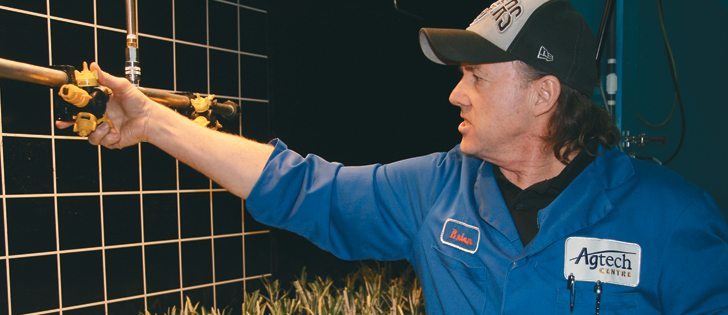There is no shortage of sprayer nozzle varieties on the agricultural market, and most, if not all of them, have been tested at Alberta Agriculture’s AgTech Centre at Lethbridge College.
At an open house Feb. 12, project manager Brian Storozynsky demonstrated the wind tunnel used to test nozzles and measure their potential to produce airborne spray drift.
The wind tunnel was built in the early 1990s to study airflow around sprayer shrouds, which were in fairly common use at the time.
The advent of high clearance, self-propelled sprayers put an end to most shroud use, partly because of their bulk, which prevented folding for transport.
The early 1990s also saw another significant change in chemical spraying.
“At about that time we started seeing drift go up, for two reasons. … A lot of the nozzles were being de-signed to accommodate rate controllers. What happened there is they were making the sprays finer and finer, the spray angles wider and wider, and we just got more and more drift.”
Read Also

Agritechnica Day 2: The future of tractor power, building quicker crop apps and large farms and tech
Agritechnica Day 2: The future of tractor power, building quicker crop apps with Syngenta and large farms and tech
Shrouds were developed to help limit the drift problem but weren’t effective, Storozynksy said.
The wind tunnel, which can generate air speeds up to 65 km-h, is used to test droplet size and drift from various nozzles.
For demonstration purposes last week, Storozynsky tested flat fan nozzles, which were popular in the 1980s, low drift nozzles popular in the 1990s and air-induced nozzles that are in vogue now.
The major potential for drift from flat fan nozzles was quickly evident through the wind tunnel’s viewing window.
“That was pretty common in the late ’80s, early ’90s,” he said of the flat fan type. “It does a great job. You get thousands and thousands of droplets in a square inch.”
But even at 25 km-h, which Storozynsky described as a typical day for spraying in southern Alberta, the drift was obvious.
Drift was reduced by about half in the low-drift nozzle test, and that amount was dramatically reduced in the venturi nozzle test. However, that doesn’t necessarily mean the venturi is always ideal, Storozynsky said.
“When you’re choosing a nozzle, you’ve got to compromise between drift and coverage. All the studies we’ve done over the years with this wind tunnel and in the field, that’s what’s come out of it. Better nozzles, nozzles with better choices.”
The data is available from the AgTech Centre.
Initial plans to put the data on Alberta Agriculture’s Ropin’ the Web site did not work out because the large amount of information could not be easily maintained.
Storozynsky said he now sends data to those who inquire.
The database allows the user to select nozzle manufacturer, model, size, application rate and pressure. The program will then list suitable choices for the task at hand.
The AgTech Centre also has a nozzle spray test patternator, built in the early 1980s to measure nozzle spray uniformity, angle and overlap. It can test 20-foot boom sections and measures at 16 millimetre intervals, which is the highest resolution in the world, according to AgTech sources.
Its high-speed sprayer test facility measures nozzle spray coverage, density and penetration at high-clearance sprayer speeds and can test at speeds up to 30 km-h.
















